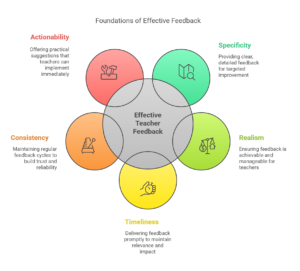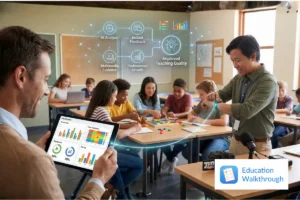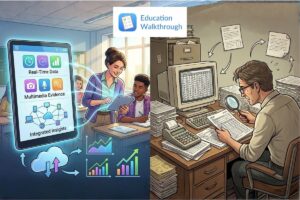What if one conversation could turn a teacher’s doubt into confidence? Feedback in K-12 schools often feels like a tightrope walk. Too harsh, and it stings. Too vague, and it’s ignored. But when delivered effectively, feedback for teachers becomes a powerful catalyst for professional growth, sharpening teaching practices, and boosting student achievement.
This guide explores proven approaches that deliver constructive feedback, support innovative teaching methods, and drive continuous improvement. Let’s explore and change the game.
Key Takeaways
- Feedback for teachers enhances teaching practices and student engagement.
- Approaches like 360-degree feedback inspire professional growth.
- Psychological safety ensures teachers embrace specific feedback.
- Structured systems deliver positive feedback for continuous improvement.
Understanding the Impact of Teacher Feedback
Why do some feedback sessions inspire while others flop? The reason is not far-fetched. It’s about intent and delivery. Let’s unpack what makes feedback for teachers a stimulus for student learning.
The Research-Backed Value of Teacher Feedback

Teaching can feel isolating, with educators craving constructive feedback to refine their teaching style. A sweeping review of 76 studies from 2012 to 2022 reveals that teacher feedback is a powerful compass guiding students through the revision process. When feedback is specific, timely, and encourages reflection and dialogue, it not only corrects errors but also boosts the quality of student work, fueling deeper learning and academic growth.
In the Leader Chat interview, Kim Marshall, a feedback expert, says “The old method of teacher supervision and evaluation was very time-consuming and often left people discouraged. I advocate for a very different and much more effective way of using observations and feedback that builds trust and focuses on improving teaching, not just judging it.”
Effective feedback is:
- Specific and actionable.
- Timely to keep context clear.
- Balanced with strengths and growth areas.
- Aligned with teaching standards.
- Focused on behaviors, not personality.
This approach transforms teaching practices and supports student achievement.
The Psychology Behind Effective Feedback Reception
Feedback that feels like a jab hits hard. Judgmental input stalls growth, but positive feedback builds confidence. Teachers experience continuous progress when feedback feels safe and collaborative.
Here’s the deal: credible sources, shared reflection, and vivid examples boost receptivity. Starting with, “What went well in that lesson?” invites teachers to reflect, setting a positive tone. As one principal shared, “I am the principal of a small school, and I’ve been using Education Walkthrough for about 6 months. What I love about this app is that it allows me to see my teachers’ progress and provide them with feedback when they need it most.”
This timely, personalized feedback creates a supportive environment where teachers feel valued and motivated to grow.
Read More: The Complete Guide to Giving Positive Feedback for Teachers
Essential Frameworks for Teacher Feedback Systems
Ready to rethink feedback? These approaches deliver positive feedback that triggers growth.
The 360-Degree Feedback Approach for Comprehensive Insight
One observer’s view of teaching is a sliver of the truth. The 360-degree feedback model gathers insights from students, peers, administrators, and self-assessments to enrich teaching practices.
What’s the spark? It reduces bias and fuels feedback for teachers. In a partner district’s classrooms, walkthrough observations were transformed into shared data that teachers could reflect on collaboratively. One teacher remarked, “Seeing the data helped me understand my teaching in a new way”.
After reviewing this anonymized feedback, 19 out of 24 teachers reported making meaningful changes to their instructional practices, especially in areas like feedback and questioning. This process of shared reflection, grounded in trust and clear examples, stimulated real instructional growth and boosted student achievement.
Feedforward: Future-Focused Improvement Strategies
Feedback often dwells on errors, but feedforward is like a playbook for the next lesson. It focuses on techniques to boost student achievement and continuous improvement in teaching practices.
When teachers collaborate with principals to plan instructional strategies like think-pair-share, the feedback process becomes a supportive coaching experience rather than a form of criticism.
Incorporating this, what you’ll get is a surge in participation learning, deeping student learning. Feedforward emphasizes:
- Upcoming teaching opportunities.
- Collaborative planning.
- Teacher-driven changes.
This approach ignites a growth mindset, encouraging innovative teaching methods.
The Sandwich Model: A Structured Approach to Blended Feedback

Want feedback that encourages growth and drives improvement? The sandwich model layers constructive feedback between positive observations, balancing affirmation and growth.
Start with praise, suggest an improvement, and end with encouragement. Providing clear, constructive feedback, such as recognizing well-defined learning objectives, encouraging varied questioning to deepen student understanding, and acknowledging positive teacher-student rapport can help educators quickly apply new strategies and boost student engagement.
Tailoring this feedback to individual needs, offering challenges to experienced teachers while giving extra support to newcomers, creates the best environment for ongoing professional growth.
Read More: Do’s and Don’ts of Giving Feedback to Teachers Post Observation
Designing Effective Teacher Feedback Content
Approaches set the stage, but content drives change. Here’s how to craft specific feedback that transforms teaching practices.
Crafting Feedback That Drives Measurable Improvement
Vague feedback is a dead end but actionable input fuels progress. Instead of “Work on pacing,” say, “Your transitions took 6 minutes. Try a timer to hit 3, per Danielson’s 2d.” This kind of clarity strengthens classroom management and supports teachers growth.
While busy leaders may skimp on details, specific feedback truly pays off. For example, noting a teacher’s questions missed half the class can lead to prompt strategies like random calling, enhancing student learning. Schools with precise, timely feedback see faster changes in student achievement and teaching methods.
Feedback Focus Areas: Beyond Basic Instructional Techniques
Focusing only on instruction misses the mark. Holistic feedback covers:
- Classroom Management: Streamlined routines, proactive approaches.
- Engagement: Equitable questions to engage students.
- Assessment: Formative checks, student feedback loops.
- Differentiation: Support for an inclusive classroom environment.
Schools using varied feedback see teachers tackle challenges, like adapting lessons for diverse learners, which improves student understanding. This instigates continuous improvement across teaching practices.
Read More: Lessons learned from my 10 years of giving teachers feedback as a principal
Implementing Feedback Systems: From Theory to Practice
Like any other ideas, great ones need solid execution. Here’s how to make feedback work in real schools.
Structured Observation Protocols and Assessment Tools
Random classroom visits often offer shallow insights. However, structured protocols turn observations into data-driven feedback for teachers.
Use templates with clear focus areas, rubrics, and digital tools, as well as streamlined observations with classroom walkthrough apps. Education Walkthrough’s templates let observers log evidence fast, targeting behaviors like questioning.
“Build reflection time into each lesson for feedback – teacher to student, student to teacher,” advises the NSW Department of Education. This principle applies equally to teacher observation systems, which should include structured reflection opportunities.
You’re probably wondering about bias in observations. It’s a legitimate concern. That’s where structured protocols come in. They help minimize this risk by focusing observers on specific evidence rather than general impressions.
Building a Positive Feedback Culture in Educational Institutions
Ever been in a school where feedback felt like a trap than support? The culture of a school greatly influences how feedback is received. When a positive culture is in place, growth is seen as the goal instead of judgment.
To do this, leaders can:
- Normalize feedback as a routine professional growth activity.
- Model receptivity to feedback at leadership levels.
- Provide feedback literacy training for all staff.
- Create psychological safety through non-punitive approaches.
- Celebrate growth resulting from feedback implementation
A principal sharing her feedback journey builds trust, encouraging teachers to seek input. Schools with strong cultures see teachers embrace positive feedback, driving an inclusive classroom environment.
Real-world implementation demonstrates how theoretical frameworks translate into measurable results.
The Freeport case study implementation showcases how structured feedback systems can transform school culture and student outcomes.
When educational leaders commit to consistent, supportive feedback practices, the ripple effects extend far beyond individual teacher growth.
This documented approach provides concrete evidence that systematic feedback delivery creates lasting institutional change.
Strategies for Effective Feedback
Let’s get practical. What specific strategies can make your feedback more impactful?
The Five ‘Be’ Statements for Effective Teacher Feedback

Need feedback that resonates? These principles deliver.
- Be Specific: “Your questions hit the front row. Try random calling for equity” beats “Improve questioning.”
- Be Realistic: One or two changes keep it doable.
- Be Timely: Timely feedback within 48 hours keeps context fresh.
- Be Consistent: Regular cycles build trust.
- Be Actionable: Suggest “Use exit tickets” with follow-ups.
These principles make feedback a roadmap for growth and continuous improvement.
Feedback Examples for Different Teacher Performance Levels
Every teacher’s path is unique. Tailor feedback to fit.
High Performer
For teachers already demonstrating excellence, feedback should focus on refinement, innovation, and leadership development.
Example: “Your questioning strategy effectively engaged 90% of students in higher-order thinking. The wait time you provided (averaging 3.5 seconds) gave students space to develop thoughtful responses. Consider how you might share these questioning techniques with department colleagues who are working on similar goals.”
Developing Teacher
Teachers showing solid progress but still developing mastery need balanced feedback that builds confidence while targeting growth areas.
Example: “Your lesson structure provided clear learning objectives that 85% of students could articulate when asked. Students demonstrated engagement through active note-taking and voluntary participation. To further strengthen student discourse, consider implementing the think-pair-share strategy before whole-group discussion to increase participation rates among quieter students.”
Struggling Teacher
Teachers facing significant challenges need supportive, targeted feedback that builds foundational skills while maintaining dignity.
Example: “I noticed your clear written instructions for the lab activity helped students understand the procedure. Several students referenced these instructions during their work.
Let’s collaborate on developing similar clarity for verbal directions, as I observed that many students asked for repetition during the introduction. I’d be happy to co-plan a lesson using the ‘What? Why? How?’ clarity framework we discussed in last week’s professional development.”
All in all, the most effective approach balances honest assessment with genuine belief in the teacher’s capacity to improve. As one expert notes, “Sometimes the feedback can also be from external sources like external trainers or non-teaching staff”, providing additional perspectives that might resonate differently.
Measuring Feedback Effectiveness
How do you know feedback works? Let’s measure it.
Feedback Implementation Metrics and Success Indicators
Great systems track impact. Monitor:
- Technique implementation rates.
- Teacher satisfaction.
- Teaching behavior shifts.
- Student learning outcomes.
Digital platforms like Education Walkthrough can facilitate this measurement by tracking feedback themes, implementation rates, and improvement trajectories over time. This data-driven approach transforms feedback from subjective impression to measurable professional development.
Continuous Improvement of Feedback Systems
The most effective feedback systems evolve based on their own results. This meta-feedback loop ensures continuous refinement.
Strategies for improving feedback systems include:
- Regular teacher surveys about feedback experiences.
- Analysis of feedback themes and patterns.
- Correlation studies between feedback and student outcomes.
- Peer review of feedback quality and consistency.
- Research partnerships to evaluate system effectiveness.
“One way to provide effective feedback is to use a skill or specific criteria to give feedback,” notes UPEducators. This specificity principle applies equally to feedback about the feedback system itself.
The most sophisticated schools create professional learning communities focused specifically on refining feedback approaches. These collaborative groups examine both research and local data to enhance feedback effectiveness.
The truth of the matter is: initial feedback systems rarely get everything right. It’s the willingness to adapt based on results that distinguishes truly effective approaches from rigid compliance exercises.
Bottom Line
Teacher feedback is almost everything you need to fuel classroom brilliance. From 360-degree insights to feedforward’s forward focus, these approaches empower teachers to upraise teaching practices and ignite student achievement. Why settle for lackluster evaluations when you can build a rocket work culture for your educators?
Trusted by instructional leaders in over 3,500 schools, Education Walkthrough creates streamlined software tools that save educators time while delivering data-driven insights that give them the confidence to make decisions.
Want to be on the winning side?
Frequently Asked Questions
What is effective teacher feedback?
It’s clear, actionable input that targets teaching behaviors, offers practical steps, and aligns with standards, helping teachers grow and improve classroom management.
How does 360-degree feedback benefit teachers?
It combines student, peer, and administrator insights to reduce bias, giving teachers a full view of their teaching practices and growth areas.
What is feedforward in teacher feedback?
Feedforward plans techniques for future lessons, like boosting student engagement with discussions, feeling like coaching rather than critique.
How can schools build a positive feedback culture?
By normalizing feedback as growth-focused, modeling openness, and ensuring a safe space, schools make input a tool for growth, not judgment.
Why measure feedback effectiveness?
Tracking technique use and teacher satisfaction ensures feedback strengthens teaching methods and student learning, keeping growth on track.



